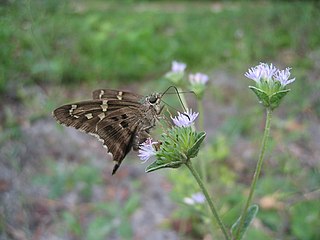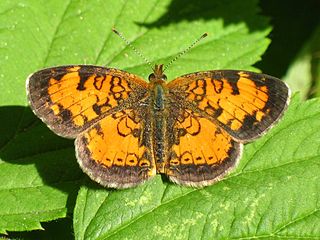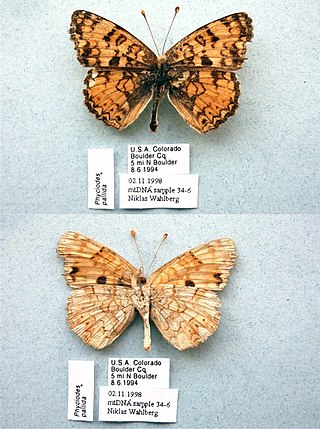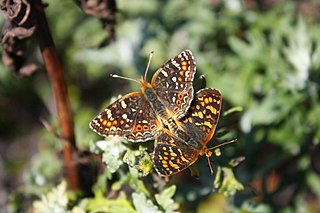
Eumaeus atala, also known as the Atala butterfly or coontie hairstreak, is a small colorful butterfly in the family Lycaenidae. It is found in southeastern Florida in the United States, Cuba, the Bahamas, and the Cayman Islands in the West Indies. Its coloration and habits are unique among butterflies within its range.

The long-tailed skipper is a spread-winged skipper butterfly found throughout tropical and subtropical South America, south to Argentina and north into the eastern United States and southern Ontario. It cannot live in areas with prolonged frost. It is a showy butterfly, with wings of light brown tinted with iridescent blue, and two long tails extending from the hindwings. The robust body is light blue dorsally. It has a large head, prominent eyes, and a wingspan between 4.5 and 6 centimeters.

The western pygmy blue is one of the smallest butterflies in the world and the smallest in North America. It has reached Hawaii, as well as the Persian Gulf, including eastern Saudi Arabia, Bahrain and the United Arab Emirates.

Faunis is a genus of Asian butterflies in the family Nymphalidae. They are among the butterflies commonly known as fauns. They are relatively small-sized amathusiins, subtly colored in soft browns and violets, and range from China to the Philippines and Sulawesi.

The pearl crescent is a butterfly of North America. It is found in all parts of the United States except the west coast, and throughout Mexico and parts of southern Canada, in particular Ontario. Its habitat is open areas such as pastures, road edges, vacant lots, fields, open pine woods. Its pattern is quite variable. Males usually have black antenna knobs. Its upperside is orange with black borders; postmedian and submarginal areas are crossed by fine black marks. The underside of the hindwing has a dark marginal patch containing a light-colored crescent.

Phyciodes cocyta, the northern crescent, is a butterfly of the family Nymphalidae. It is found in the Nearctic realm.

Phyciodes, the crescents or crescent spots is a genus of butterflies of the subfamily Nymphalinae in the family Nymphalidae.

Mimoides phaon, the red-sided swallowtail or variable swallowtail, is a species of butterfly in the family Papilionidae. It is native to the Americas.

Phyciodes pallida, the pale crescent or pallid crescentspot, is a species of butterfly in the family Nymphalidae. It is found in western North America.

Phyciodes mylitta, the Mylitta crescent or Mylitta crescentspot, is a butterfly of the family Nymphalidae. It is found in western North America.

Phyciodes pulchella, the field crescent, is a butterfly of the family Nymphalidae. It is found in the Nearctic realm.

Phyciodes orseis, the Orseis crescentspot or California crescent, is a species of butterfly in the family Nymphalidae. It is found in western North America, particularly northern California and Oregon. Formerly, The range was thought to extend along the Coast Range as far south as San Francisco. However, they were either mislabeled or are currently extirpated from these regions. The habitat consists of mountain valleys, meadows and stream canyons. Along with roughly 120 other species, they are check-listed as butterflies occurring on or near the Fremont-Winema National Forests. This checklist has been established based on observations throughout Lake and Klamath counties in Oregon. The list is maintained by the Forest Service in order to monitor health of native ecosystems. Monitoring population levels of butterflies such as P. orseis over time provides a metric for these efforts. These pollinators play an integral role in such systems, as they are beneficial both for the flora of the region and as food sources for regional avian species.
Phaon is a boatman from Greek mythology, lover of Sappho.














